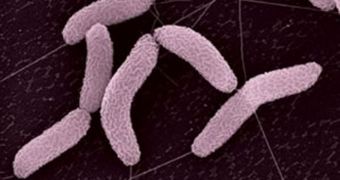Scientists at the US Department of Energy's (DOE) Lawrence Berkeley National Laboratory (Berkeley Lab) announce that they were recently able to reveal the secrets of a bacteria known for its ability to remove toxic and radioactive materials from the environment.
While researchers learned about the microorganism's capabilities some time ago, they failed in discovering the exact genetic factors that allowed the small bacteria to survive – and even thrive – in such hostile habitats, which are lethal to everything else.
In the new investigation, the Berkeley Lab team decided to remove these uncertainties, so it created a the first genetic map explaining how this bacteria's genes interact with each other and the environment to underly its amazing abilities.
Berkeley Lab Physical Biosciences Division chemist Aindrila Mukhopadhyay was the leader of the new research effort, which was focused on the sulfate-reducing bacterium Desulfovibrio vulgaris.
“Knowing how bacteria respond to environmental changes is crucial to our understanding of how their physiology tracks with consequences that are both good, such as bioremediation, and bad, such as biofouling,” Mukhopadhyay explains.
“We have reported the first systematic mapping of the genes in a sulfate-reducing bacterium – Desulfovibrio vulgaris – that regulate the mechanisms by which the bacteria perceive and respond to environmental signals,” she adds.
Details of the study appear in a paper entitled “Systematic mapping of two component response regulators to gene targets in a model sulfate reducing bacterium,” which is published in the latest issue of the esteemed scientific journal Genome Biology.
Mukhopadhyay, a corresponding author of the new paper, holds joint appointments with the DOE Bioenergy Research Center and the Joint BioEnergy Institute (JBEI). She explains that D. vulgaris can be classified as a anaerobic bacterium.
The microorganism drew negative attention to itself for its ability to metabolize metals, meaning that it could, for instance, eat most parts of a car. However, the enzymes it generates can also reduce toxic heavy metals and radioactive nuclides.
“For all of these reasons, it is important that we understand the molecular signaling systems by which D. vulgaris interacts with and survives in its many different environments,” Mukhopadhyay explains.
“Yet, after more than seven decades of study, not a single one of the approximately 70 known molecular signaling systems in D. vulgaris had been characterized,” she concludes.
The DOE Office of Science provided the funds needed for this research.

 14 DAY TRIAL //
14 DAY TRIAL //